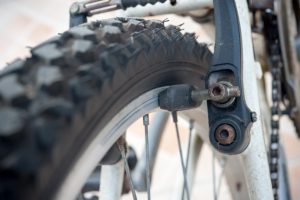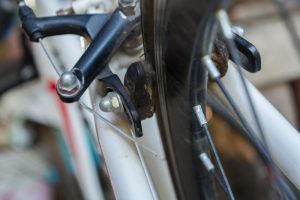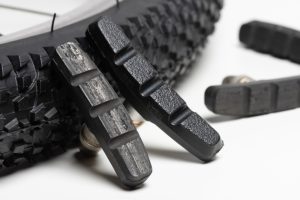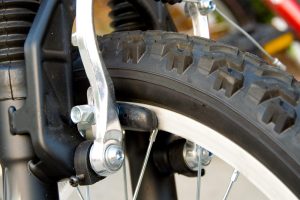
Brakes are an essential factor when it comes to vehicles. Bike failures are also an important reason contributing to road accidents. Looking after them and inspecting them before leaving home is necessary every time. In this article, we will briefly discuss the lifetime of brake pads, why it is important to learn about brake pads and the underlying mechanisms, how critical it is, and when you have to do a replacement. As a whole, even a pair of average-quality brake pads can easily last about 2000 – 4000miles on average under usual riding conditions and methods of usage.
High-quality ones can last longer than this. When you say these numbers in time, it will be around 2 – 5 years. Rim brakes and Disc brakes both will fall under this situation. This can be applied to both rim brakes and disc brakes. Look for noise or high-effort brakings and decline in performance to indicate the failure of the brake pad and try to look more closely to find the issue.
A braking system in e-bikes is not the same as in traditional bikes. Because many factors starting from the weight, functions of the motor, higher speeds, and pedal assist mechanisms also make it complicated to control the e-bike correctly and slow down when the brake is applied.
Necessary parts of the braking system and its maintenance

-
Brake pads
Brake pads use friction and squeeze the brake rotor to slow down the vehicle by slowing down the revolution of the rim or a disc attached to the rim. Inspecting the brake pad’s condition is a good step to start when you have experienced a failure in the braking system. The new pair of brake pads will be 13mm in thickness, if it will start to shrink to about 3-5mm thick or less you have to do a replacement with a new set of compatible brake pads. Regular cleaning also keeps them functioning effectively.
-
Mechanical brake rotor
Brake rotors are for safely stopping your e-bike when every time you pull the brake lever. They are large metal disc kinda structures, which can be found on disc brake wheels. Panic breakings, applying the brake continuously and old brake pads are common reasons for rotors wear down. When it comes to braking, rotors are much important as brake pads. If you feel a vibration or a squealing noise while applying the brakes you have to start the inspection from here.
-
Brake lever
Levers can easily get loosen up over time because of various reasons. The common reason for this is the dirt accumulating inside the lever hinge. Applying lubricant may help to ease the braking experience and also can clean the dirt as well.
-
Brake cable
The brake cable connects the brake handle to the braking mechanism either it can be just a rim brake or a disk brake. They may stretch out as time passes. Damages in the cable housings or exposure to dirt can drag this into serious problems.
How to inspect your e-bike’s brake pads?

For a better lifespan, you have to do visual checkups at regular intervals. There are some methods to get to know about when your brake pad needs a replacement.
-
Harsh, grinding, and scraping metal sound
This indicates that the brake caliper is keep scraping on the disc of the brakes. They have to be visually checked more closely and perform a replacement. If the pads are getting thin by friction, that indicates the brake pads contact the disc or drum.
-
Takes a longer time to perform braking
This shows that the brake pads were worn out or your cables failed. For this, you have to replace your cables or grease the cable, or need to do a brake pad replacement.
-
Requires more power to brake
It’s likely due to poor efficiency of lever and cable, you need to put grease and adjust the cables to achieve effortless braking.
Symbols and letters on the pad boxes

A, B, and N are a set of rules passed by the government of California and Washington and regulated by NSF international. Mainly to mark down the toxic and environmentally harmful materials such as mercury, cadmium, chromium, and lead that can be harmful to fish or wildlife. The three-leaf symbol marked on the box refers to the copper in brake pads and is simply referred to as “Look for the leaf and Look for the copper”. According to the law, there will be a three-level acceptance of the materials. A will contain only cadmium, chromium, mercury, and lead. B will contain copper additionally. Level N brake pads are referred to as zero-copper guaranteed.
The two-letter dot grading system refers to the coefficient of friction, also known as COF. High letters indicate a high level of coefficient of friction. The majority of replacement pads are coming with the ratings of EE or FF. For high-performance or heavy-duty applications, a pad with a GF rating has more compatibility. A GG rating has more aggressive usage against heat and cold conditions. These are some kind of the additional categorization techniques than categorizing it by brake pad thickness, rotor designs, hole setup for cooling purposes, chamfers, and, shape.
Reasons for damages and wear-outs

Below things are the factors that determine the lifespan of your brake pads. So, make sure you have control over it. Starting with,
-
Quality
High-quality brake pads are often made from high-quality raw materials like ceramic and semi-metallic blends. High-quality ones will always provide a good amount of friction and can easily adapt to different platforms. Sometimes low quality brake pad manufacturers will intentionally use low-quality blends to compromise the price. This will end up in noisy unfit brake pads, which sounds always “Creech.. Kreech..”. So, choose wisely when it comes to essential items.
-
Type of raw materials
As we said in the above section, choosing high-quality ones will have the right blend of things. They can easily last for years. You have choices between a range of materials like metallic, organic, resin, and semi-metallic. Also, consider your budget range, since they can easily affect the prices of the brake pads. Look at the table below.
| Material | Organic | Semi-metallic | Metallic |
| Cost | $ | $$ | $$$ |
| Performance | # | ## | ### |
| Longevity | # | ## | ### |
Organic ones are made up of a blend of rubber, carbon, and sometimes fiber. Metallic ones are the expensive models, but, when it comes to performance and longevity they will ace. So, if you have enough bucks, go with the high-quality ones. According to the comparison, don’t conclude like, organic ones aren’t usable at all. The reality is organic ones are a great choice for smooth and noise-free rides.
The quality and the materials also result in comfy pedaling. The organic brake pad seems to give a spongy soft pedal feel since it’s soft compared to other materials. Semi-metallic or ceramic ones seem to provide a relatably soft feel than metallic pads.
-
Weather
Weather conditions also probably affect your components not only these brake pads but also other mechanical components. Dry and sunny weather are the most suitable conditions for mechanical components. It’s always advisable to replace the brake pads quickly if you’re living in a moist and cold place.
-
Riding habit
This also plays a vital role in longevity. if you’re a slow ride enjoyer don’t worry, your brake pads will last for at least a couple of years even if the manufacturing quality is poor and you’re living in extreme weather conditions. Because fast rides force mechanical parts to function fast. This will end up in wearing out early. Riding habit also includes excessive braking which we have discussed in the upcoming sections.
-
Bike weight
If you are considering the resultant force of the bike’s and rider’s weight together, that will impact the amount of force that is needed for an e-bike to operate. This will directly affect the lifespan of the brake pad. When you consider this, the increased weight will result in decreasing lifespan. Always try to avoid lean forward while driving. It will result in shifting the mass to the front wheel, so that, the front brake pads will get damaged easily. Make sure your mass and resultant force are in the center of your bike.
-
The riding environment
like hillside, beachside, muddy areas, and rocky terrains play a significant role in keeping up the lifespan of brake pads. They can be worn out easily if salt or dirt from various environments sticks between pads and wheels. Also, if you are living on a terrain or urban side, you have to use a brake very often. The excessive usage of them also leads them to wear down too early.
-
Contamination
As we discussed earlier, the environment plays a vital role in the brake pad’s lifespan, contamination also plays the same role. Contamination contains a series of things, for example, it can be caused by mud, grease, dirt from roads, microparticles that come with wind or dust, and even debris. Have to maintain a cleaning process regularly.
-
Unnecessary heat and operating temperature
An excessive amount of heat produced in the nearby areas is another kind of threat to the brake pad’s longevity. Routine driving often causes the temperature to rise around 300-450 degrees. Additionally, improperly installed ones, previous damage to the discs, and, worn-out discs also may cause heat. When every time, you go for a replacement, make sure you have identified the right brake pad type, and replaced one is the same type as the one which is already installed. The easiest way to identify the existing brake pad model is just by looking at the lever of the pad or the caliper. It all depends on the friction. No? Proper maintenance of all this can preserve the lifespan of your brake pads. Always consider inspecting them by just looking at them at regular intervals.
-
Poor compatibility
Even though brake pads are universal every e-bike manufacturer has its set of unique designs and suggested brands. Even if they are benefitting from the affiliation, replacing the exact brake pads they recommend can help you to avoid misfits, unprepared circumstances, and warranty-related issues. Some of the e-bike braking systems are very sensitive since they are well equipped and have rich sensors that monitor every action.
Tips for correct braking, that could save your brake pads from wear-outs.

If you’re a newbie of e-bikes, first practice on the empty roads to get a clear understanding of brakings and their underlying functions and mechanisms, so that you can adapt to various conditions and you can also rapid response when brake failure happened. If you’re riding downhill, the higher kinetic energy levels caused by the shape of the road make it harder to achieve braking within a limited braking distance. So respond quickly when you’re applying the brake. This can help you to maintain the life span of brake pads for sure. You can also apply intermittent braking if you’re riding downhill.
Modern e-bikes come in different styles and designs and also for different purposes. We can’t so sure about that every one of them will come as well-balanced ones. As we said earlier, correct weight distribution also matters, when it comes to effective braking. Regular cleaning or at least regular checkups can help you to find the chaos quickly. So that, you can prevent any inconvenience before it happens. For these inspections, you don’t have to be familiar with technical stuff. Just read this article again and go through the processes.
If you have to apply brakes on roads where you can find a lot of traction there, for example, normal roads or grippy rocky roads you have to brake more heavily than usual to achieve slow down. If you are traveling on loose gravel or slippery or even muddy/sandy roads where traction will be very low, you should not have to apply brakes forcefully or heavily. It will end up slipping your bike.
Cleaning the pads increases their lifespan

Before considering the cleaning process, make sure you have these things. Starting from, Sandpaper and a 70% alcohol clean kit. 150-grit sandpaper is recommended. Put the sandpaper on the table or any kind of flat surface and rub the brake pads gently and slowly on the sandpaper until the dirt is removed. Once you have finished cleaning the pads, you can apply a little amount of alcohol with a sponge or a cloth. Then lighting the pads helps you to remove dirt and the residual amount of oil and grease that stick on the pads. Finally, clean it with a cloth and fix them to the wheel.
Keep doing this as a habit at a regular interval of 3 months or higher. Before fixing back them, clean the rotor area as well.
Final thoughts

Many people will be in the confusion stage, which should they have to change the two pairs of brake pads at once. As you all know, There will be a pair of brake pads on the front and rear wheels of the e-bike. It is necessary to replace the pair of pads at once like either the front wheels or rears. But, you shouldn’t have to replace the pads of both wheels at once. If you’re considering the budget as a whole, you can go with also replacing four-wheel pads at once.
Even if we are controlling all the external things and keep inspecting at regular intervals, at the end of the day, it all depends on our usage and the way we maintain and ride the bike. Brakes are one hell of an important thing that helps you to safely operate your bike. All the above numbers were mentioned just for reference and a rough understanding of this section. That doesn’t mean your brake pads are also following the same norms. If you keep riding with worn-out brake pads, your rotor will get eaten up which will lead to several serious problems. High-quality products often cost you more than regular ones. Don’t hesitate to spend more when it comes to safety. OEM is one of the existing tricks to get high-quality brake pads at a cheap price.
